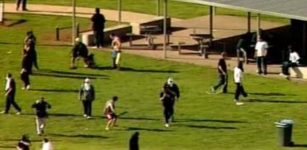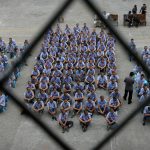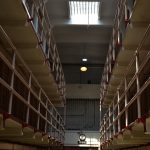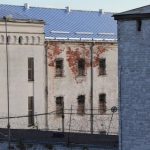Inmate Sentenced Over Victorian Prison Riot

Johnathan Luca is the first inmate to be sentenced over the Ravenhall prison riot, which broke out at Melbourne’s Metropolitan Remand Centre on June 30 last year.
On Monday, Luca had another 12 months added to his minimum sentence, after being one of the first inmates to plead guilty to a charge of riot.
The County court heard that during the largest prison riot in Victorian history, the 22-year-old was captured on camera “strutting around” and looting the canteen.
Luca has already spent 18 months in custody and was due for release in April 2017, but will now be spending at least another year behind bars.
A total of 102 inmates were charged over the 15-hour riot that broke out a day before a smoking ban took effect in all of the state’s thirteen prisons.
The smoking ban
In 2014, the Napthine government passed legislation making it a crime to smoke in Victorian prisons as of July 1, 2015. At the time, 80 percent of the Ravenhall prison population smoked.
Months before the ban took effect, there were rumours in the press that taking away prisoners’ rights to smoke could cause a riot.
But on June 19 last year, when the sale of tobacco at the prison canteen was finally shut off, tensions began to simmer.
On the day of the riot that caused $12 million in damages, around 50 inmates gathered in one area of the prison in what appeared to be a peaceful protest. However, the number swelled to 400 after internal fences were pushed down.
The inmates began chanting, “We want Ox” – a reference to White Ox pouch tobacco: the brand of choice for inmates.
Anarchy prevails
Inmates then began brandishing metal posts and pulling t-shirts over their heads to disguise their identities.
They forced their way into a control room at around 12:20pm, before prison staff called a riot and retreated to safety.
In the ensuing chaos, rioters broke into other areas of the prison and got hold of vehicles, some of which they set alight.
They armed themselves with makeshift weapons, acquired tools and broke into accommodation units, releasing other inmates.
Around 200 prison staff were evacuated and all of the state’s other prisons went into lockdown as a precaution.
As the afternoon wore on, heavily armed critical incident response police officers stormed the maximum-security prison that’s located in Ravenhall, 20 km west of Melbourne’s CBD.
As police tried regain control, some inmates were hijacking a tractor, while others lit a bonfire and threw a golf buggy on it. This left the prison shrouded in smoke for most of the afternoon.
At around 8:30 pm, Victoria police and Corrections Victoria security forces executed an action plan that led officers to regain control of the facility.
By 3 am on July 1, all prisoner units had been secured, with a final inmates count taking place at 7am that morning.
The Walshe report
An independent investigation into the unprecedented riot was undertaken by former Victoria deputy police commissioner Kieran Walshe, whose final report was released in December last year.
The investigation found that senior staff had ignored a series of warnings prior to the breakout of the riot.
These included uncovering a stash of knives and balaclavas in early June, inmates making a drill bit that was used to remove cell doors, and prisoners kicking footballs at the internal fences to test their strength.
Prison overcrowding
The report also found that a major contributing factor to the riot was overcrowding in the prison, as there had been a rapid rise in inmate numbers in previous years.
The Ravenhall prison opened in 2006 as a 613 bed single-cell facility. But by the time of the riot, the population had grown to 918 inmates, with 750 single and double-cells.
Liana Buchanan, executive officer of the Federation of Community Legal Centres, said remand numbers were up by 60 percent over the four years prior.
In her opinion, it was time for the Victorian government to implement “plans to reduce the numbers of unsentenced people held in prison.”
In response to the report, the state government announced it was going to undertake a $52 million security upgrade of the prison that included replacing internal wire fences with concrete walls.
Victorian corrections minister, Wade Noonan, said there was no one to blame for the riot but the prisoners, who thought they were above the law.
Scarce tobacco
But it’s easy to see how tensions could rise after the supply of tobacco – a substance that’s highly addictive and notoriously hard to quit – was cut off, especially when most inmates smoked.
Three days before the riot, it came to light that some of the inmates were still being given tobacco to placate a group who threatened to cause unrest.
Stockpiles of tobacco were being sold at $350 a pouch, while the number of standovers and assaults were increasing as supplies dwindled.
A similar ban was implemented in Queensland prisons in 2013. At the time, there was a spike in attacks on prison guards, especially during the period between the canteen cutting off sales and the ban itself.
Passive protests
However, the Walshe report also identified two passive protests that took place in the remand centre in the days preceding the riot.
On June 25, 90 inmates congregated in the Area 3 yard and produced a letter requesting a postponement of the ban until October.
And on June 28, another protest of around 50 inmates occurred. On that occasion, a letter was produced that listed a number of men who hadn’t received their final quota of tobacco.
The US prison strike
In September of this year, the largest prison strike in US history took place, when tens of thousands of inmates from over 40 prisons across 24 states stopped work.
The primarily peaceful protest commenced on September 9 – the anniversary of the Attica Prison uprising – and aimed to bring an end to free prison labour.
Sydney Criminal Lawyers® contacted the Incarcerated Workers Organizing Committee – one of the main organising groups behind the strike, on Wednesday.
We were told there were still ongoing hunger strikes in Wisconsin and California, but for the time being there were no more work stoppages.
The group said more strikes will be forthcoming, but in the meantime they’re focusing on the Millions for Prisoners Human Rights March on Washington DC on August 19 next year.







